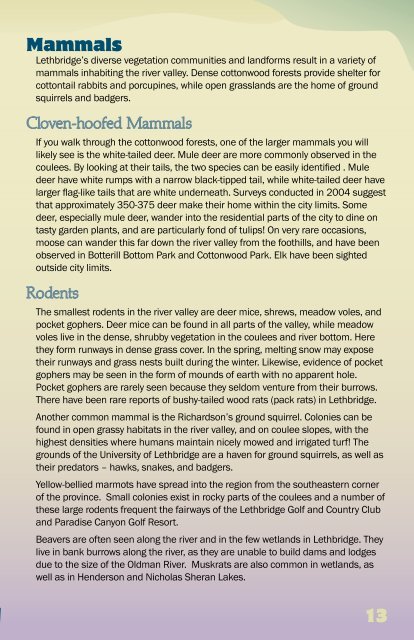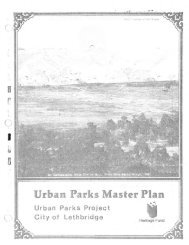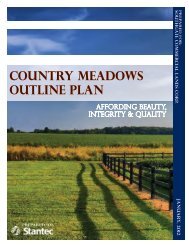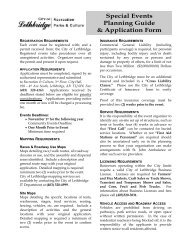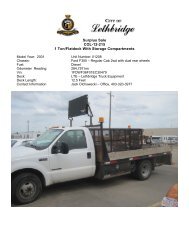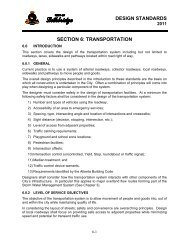Coulees Cottonwoods - City of Lethbridge
Coulees Cottonwoods - City of Lethbridge
Coulees Cottonwoods - City of Lethbridge
You also want an ePaper? Increase the reach of your titles
YUMPU automatically turns print PDFs into web optimized ePapers that Google loves.
Mammals<br />
<strong>Lethbridge</strong>’s diverse vegetation communities and landforms result in a variety <strong>of</strong><br />
mammals inhabiting the river valley. Dense cottonwood forests provide shelter for<br />
cottontail rabbits and porcupines, while open grasslands are the home <strong>of</strong> ground<br />
squirrels and badgers.<br />
Cloven-ho<strong>of</strong>ed Mammals<br />
If you walk through the cottonwood forests, one <strong>of</strong> the larger mammals you will<br />
likely see is the white-tailed deer. Mule deer are more commonly observed in the<br />
coulees. By looking at their tails, the two species can be easily identified . Mule<br />
deer have white rumps with a narrow black-tipped tail, while white-tailed deer have<br />
larger flag-like tails that are white underneath. Surveys conducted in 2004 suggest<br />
that approximately 350-375 deer make their home within the city limits. Some<br />
deer, especially mule deer, wander into the residential parts <strong>of</strong> the city to dine on<br />
tasty garden plants, and are particularly fond <strong>of</strong> tulips! On very rare occasions,<br />
moose can wander this far down the river valley from the foothills, and have been<br />
observed in Botterill Bottom Park and Cottonwood Park. Elk have been sighted<br />
outside city limits.<br />
Rodents<br />
The smallest rodents in the river valley are deer mice, shrews, meadow voles, and<br />
pocket gophers. Deer mice can be found in all parts <strong>of</strong> the valley, while meadow<br />
voles live in the dense, shrubby vegetation in the coulees and river bottom. Here<br />
they form runways in dense grass cover. In the spring, melting snow may expose<br />
their runways and grass nests built during the winter. Likewise, evidence <strong>of</strong> pocket<br />
gophers may be seen in the form <strong>of</strong> mounds <strong>of</strong> earth with no apparent hole.<br />
Pocket gophers are rarely seen because they seldom venture from their burrows.<br />
There have been rare reports <strong>of</strong> bushy-tailed wood rats (pack rats) in <strong>Lethbridge</strong>.<br />
Another common mammal is the Richardson’s ground squirrel. Colonies can be<br />
found in open grassy habitats in the river valley, and on coulee slopes, with the<br />
highest densities where humans maintain nicely mowed and irrigated turf! The<br />
grounds <strong>of</strong> the University <strong>of</strong> <strong>Lethbridge</strong> are a haven for ground squirrels, as well as<br />
their predators – hawks, snakes, and badgers.<br />
Yellow-bellied marmots have spread into the region from the southeastern corner<br />
<strong>of</strong> the province. Small colonies exist in rocky parts <strong>of</strong> the coulees and a number <strong>of</strong><br />
these large rodents frequent the fairways <strong>of</strong> the <strong>Lethbridge</strong> Golf and Country Club<br />
and Paradise Canyon Golf Resort.<br />
Beavers are <strong>of</strong>ten seen along the river and in the few wetlands in <strong>Lethbridge</strong>. They<br />
live in bank burrows along the river, as they are unable to build dams and lodges<br />
due to the size <strong>of</strong> the Oldman River. Muskrats are also common in wetlands, as<br />
well as in Henderson and Nicholas Sheran Lakes.<br />
13


